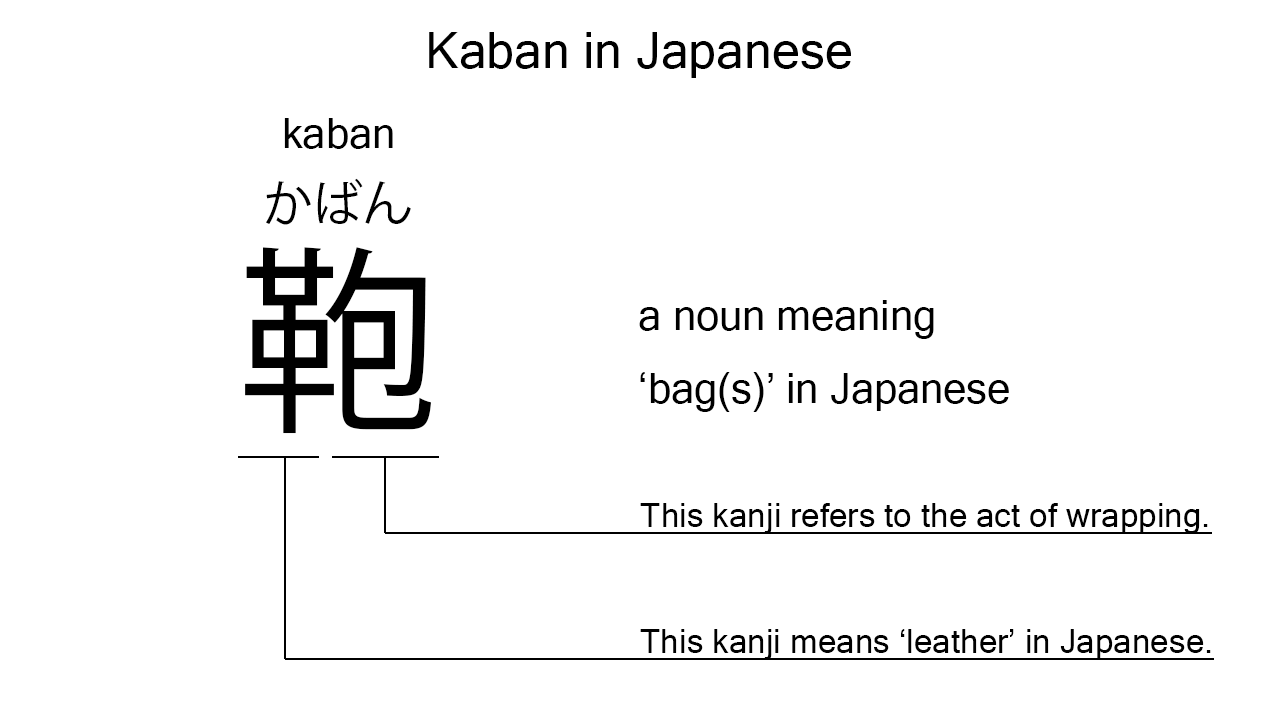What does “kaban” mean in Japanese?
Native speakers say “kaban” to mean ‘bag’ in Japanese. Perhaps, some Japanese learners know this word as it is sometimes used in Japanese conversations. In this blog post, however, I will explain this word in detail based on its kanji character. And also, I will explain how to use it through example sentences. My explanations would help Japanese learners understand “kaban” more clearly. Then, let’s get started!
Contents
Definition and meaning of “kaban”
Let me start with the definition and meaning of “kaban”.
- kaban – 鞄 (かばん) : a noun meaning ‘bag’ in Japanese. This can also work as plural. Learn more about Japanese plural.
The definition and meaning are simple and clear. To understand this noun more clearly, however, let me explain its kanji character in detail.
What does “kaban” literally mean in Japanese?
The kanji character of “kaban” consists of the following two parts:
- 革 : a kanji character used to mean ‘leather’ in Japanese.
- 包 : a kanji character used to refer to the act of covering or wrapping. This is not completely the same as the right part of “鞄”, but both have the same root.
From these two kanji parts, we can understand that “kaban” literally means ‘leather for wrapping’ in Japanese. This literal interpretation is not completely in line with the actual meaning, but still understandable, I think. People in the past used a piece of leather to wrap things to carry.

When we meet new kanji characters, we should check their parts in detail to understand their meanings clearly and deeply. In many cases, kanji parts tell us a lot about the meanings of the characters they form. Actually, here, we could get the better understanding of “kaban” through the detailed check above.
So far, I’ve explained the definition and meaning of “kaban” together with its kanji parts. Then, let me explain how to use it through the example sentences below.
Example #1: how to say “bag” in Japanese
kore wa boku no kaban desu – これは僕の鞄です (これはぼくのかばんです)
This is my bag.
Below are the new words used in the example sentence.
- kore – これ : a demonstrative pronoun used to refer to something close to the speaker. In the example, this is used to mean ‘this’ in Japanese.
- wa – は : a binding particle working as a case marker or topic marker. In the example, this works after “kore” to make the subject in the sentence.
- boku – 僕 (ぼく) : a pronoun meaning ‘I’ in Japanese. This is used mainly by boys and young males.
- no – の : a case particle used after a noun or pronoun to make its possessive case. In the example, this is used after “boku” to make its possessive case, “boku no”, which means ‘my’ in Japanese.
- desu – です : an auxiliary verb used after a noun or adjective to make it polite. Probably, this is well known as a part of Japanese desu form. In the example, this is used after “boku no kaban” to make it sound polite.
This is a typical usage of “kaban”. In this example, it works together with the possessive case, “boku no”, to mean ‘my bag’ in Japanese.
Example #2: another usage of “kaban”
kanojo wa musume ni atarashii kaban wo kat ta – 彼女は娘に新しい鞄を買った (かのじょはむすめにあたらしいかばんをかった)
She bought her daughter a new bag.
Below are the new words used in the example sentence.
- kanojo – 彼女 (かのじょ) : a pronoun meaning ‘she’ in Japanese.
- musume – 娘 (むすめ) : a noun meaning ‘daughter’ in Japanese. This can also work as plural.
- ni – に : a case particle used to say to whom an action is directed. In the example, this is used after “musume” to say to whom she bought a new bag.
- atarashii – 新しい (あたらしい) : an i-adjective meaning ‘new’ in Japanese. In the example, this works to modify “kaban”.
- wo – を : a case particle used to make the object word in a sentence. In the example, this is used after the noun phrase, “atarashii kaban”, to make the object in the sentence.
- kat – 買っ (かっ) : one conjugation of the verb, “kau“, which means ‘to buy’ in Japanese. In the example, it has been conjugated for the better connection with its following word.
- ta – た : an auxiliary verb used after a verb, adjective, or auxiliary verb to make its past tense form. In the example, this is used after “kat” to make its past tense form, “kat ta”.
This is another typical usage of “kaban”. In this example, it works together with the i-adjective, “atarashii”, to mean a ‘new bag’ in Japanese. When we want to mean a ‘bag’ or ‘bags’ in Japanese, anyway, this noun is always a very good option.
Summary
In this blog post, I’ve explained the definition and meaning of “kaban” in detail based on its kanji character. And also, I’ve explained how to use it through the example sentences. Let me summarize them as follows.
- kaban – 鞄 (かばん) : a noun meaning ‘bag’ in Japanese. This can also work as plural. Two kanji parts, “革” and “包”, literally mean ‘leather for wrapping’ in Japanese. This literal interpretation is not completely in line with the actual meaning, but still understandable, I think. People in the past used a piece of leather to wrap things to carry.
Hope my explanations are understandable and helpful for Japanese learners.